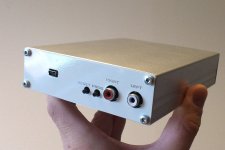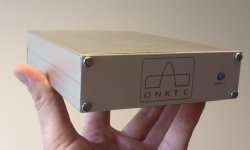You can download some DXD for free from 2L - the Nordic Sound - follow the link to 'Test Bench' and scroll down for special resolutions. Dunno if they count as an experimental studio setup though 😉
<edit> - ah, I see UnixMan already mentioned them 🙂
<edit> - ah, I see UnixMan already mentioned them 🙂
Last edited:
yup. What I did not mention is they those files appears to be band-limited (to about 20-22KHz) and with plenty of noise-shaping applied. 🙄You can download some DXD for free from 2L - the Nordic Sound - follow the link to 'Test Bench' and scroll down for special resolutions. Dunno if they count as an experimental studio setup though 😉
<edit> - ah, I see UnixMan already mentioned them 🙂
Looks like they are likely master files prepared for standard CDDA production...
Nevertheless, they sound terrific. 🙂 (even after the sox downsampling to 24/192 which was required to be able to listen to them on my system).
Last edited:
Glad I didn't waste my HDD space trying to download them then. What's the point of having a heavily processed file in such a format? I have downloaded some of their lower res files and found them to sound impressive though.
Sweet. I didn't know that.
Anyway. If possible supporting these super-high-res formats is desirable, however my point was that there isn't really any material out there, is there?
Anyway. If possible supporting these super-high-res formats is desirable, however my point was that there isn't really any material out there, is there?
Relatively speaking, no there isn't. I tend to spend my time getting better sound from all the 44/16 material I have rather than chasing hi-res. Wasn't it Holt's law that goes 'the better the recording quality, the poorer the music' ?
Oh! that would be a big news! How is that possible? what hardware+software is required?Now that SACD backups are possible, DSD playback will become increasingly popular.
Just curious.
1. Anybody out there who tried the impact - -- if there's any 😉 -- of earlier discussed PC optimizations?
Let's assume there are differences:
2. What do you guys think of the two stage jitter supression (widget + FIFO) +
the isolation (as done on exau2i) in between.
Not to forget:
All that should be able to run up2 8 channels of course. Over here we're still talking stereo - correct?
8*192khz might be considered a kind of challenge. Though the exau2i guys are setting the pace. That product IMO should
be considered reference for now.
Cheers
1. Anybody out there who tried the impact - -- if there's any 😉 -- of earlier discussed PC optimizations?
Let's assume there are differences:
2. What do you guys think of the two stage jitter supression (widget + FIFO) +
the isolation (as done on exau2i) in between.
Not to forget:
All that should be able to run up2 8 channels of course. Over here we're still talking stereo - correct?
8*192khz might be considered a kind of challenge. Though the exau2i guys are setting the pace. That product IMO should
be considered reference for now.
Cheers
Last edited:
Hardware available now
Hi guys,
the full batch of AB-1.1 boards just arrived with me. That means I'll start shipping out complete units very soon, probably Monday. Here are some pictures.
I'll install a firmware image which is performing well with UAC1 (44.1 and 48) on Windows. UAC2 (44.1-192 on Linux and Mac) is in the image, but you'll need drivers and the WidgetConfig program to set it. Join the sdr-widget and audio-widget mailing lists for details.
The price is still $120 plus shipping 🙂 ($31 international, $18 Europe)
Cheers,
Børge
Hi guys,
the full batch of AB-1.1 boards just arrived with me. That means I'll start shipping out complete units very soon, probably Monday. Here are some pictures.
I'll install a firmware image which is performing well with UAC1 (44.1 and 48) on Windows. UAC2 (44.1-192 on Linux and Mac) is in the image, but you'll need drivers and the WidgetConfig program to set it. Join the sdr-widget and audio-widget mailing lists for details.
The price is still $120 plus shipping 🙂 ($31 international, $18 Europe)
Cheers,
Børge
Attachments
Main project pages:
sdr-widget - Audio and Control Interface for Amateur Radio SDR and Audiophile USB-DAC - Google Project Hosting
https://groups.google.com/group/audio-widget?hl=en
It's been a while since I actually joined the projects, so I don't remember the details. Cookies log me in whenever I go there...
Børge
sdr-widget - Audio and Control Interface for Amateur Radio SDR and Audiophile USB-DAC - Google Project Hosting
https://groups.google.com/group/audio-widget?hl=en
It's been a while since I actually joined the projects, so I don't remember the details. Cookies log me in whenever I go there...
Børge
Hello borges ,
I just discover this thread and the project seem to be very very interesting !
I use for a year now a linux OS on my computer, and i looked to get a good USB audio device for listening music.
A device supporting high sampling rate is also one of my requirement.
Please, can you confirm me that your AB-1.1 board support Linux OS (with drivers) and all sampling rate to 192kHz and resolution between 16-24 bits ?
On your post #210, you speak about a price of 120$, what is included for that price ?
(Sorry if the info has already been said, i don't found it !).
Regards, and thank you very much for sharing this high-end projects!
Frex
I just discover this thread and the project seem to be very very interesting !
I use for a year now a linux OS on my computer, and i looked to get a good USB audio device for listening music.
A device supporting high sampling rate is also one of my requirement.
Please, can you confirm me that your AB-1.1 board support Linux OS (with drivers) and all sampling rate to 192kHz and resolution between 16-24 bits ?
On your post #210, you speak about a price of 120$, what is included for that price ?
(Sorry if the info has already been said, i don't found it !).
Regards, and thank you very much for sharing this high-end projects!
Frex
Hi Frex,
On Linux (kernel 2.6.38 or later) the audio-widgets are supported by the native USB Audio Class 2 (UAC2). No drivers needed.
You will need to download a GUI utility called WidgetControl.py GUI tool from the Google Project Hosting link:
Downloads - sdr-widget - Audio and Control Interface for Amateur Radio SDR and Audiophile USB-DAC - Google Project Hosting
You will need python, pyusb, pythoncard etc. to be installed in your Linux machine to run this GUI.
With the GUI, you can configure the firmware for UAC2 (instead of the default UAC1 for Windows compatibiilty). Under UAC2, the audio-widgets are capable of 44.1/48/88.2/96/176.4/192khz. The USB transfer is at 32 bits, but only the most significant 24 bits are actually transferred to the ES9023 DAC. If you play 16bit music, the other 8 bits are padded to zeros by Linux.
The audio-widget can be set up to be used with pulseaudio. However, to get the most out of pulse, you need to setup pulse correctly using the .pulse/daemon.conf file.
The best player I have found is MPD. You can setup the .mpdconf file so that there is no auto-resampling. So whatever the source material sampling rate is, the same sampling rate is set for the audio-widget and the samples transferred are "bit-perfect".
You should join the audio-widget Google group and read all the archived info if you are interested.
Alex
On Linux (kernel 2.6.38 or later) the audio-widgets are supported by the native USB Audio Class 2 (UAC2). No drivers needed.
You will need to download a GUI utility called WidgetControl.py GUI tool from the Google Project Hosting link:
Downloads - sdr-widget - Audio and Control Interface for Amateur Radio SDR and Audiophile USB-DAC - Google Project Hosting
You will need python, pyusb, pythoncard etc. to be installed in your Linux machine to run this GUI.
With the GUI, you can configure the firmware for UAC2 (instead of the default UAC1 for Windows compatibiilty). Under UAC2, the audio-widgets are capable of 44.1/48/88.2/96/176.4/192khz. The USB transfer is at 32 bits, but only the most significant 24 bits are actually transferred to the ES9023 DAC. If you play 16bit music, the other 8 bits are padded to zeros by Linux.
The audio-widget can be set up to be used with pulseaudio. However, to get the most out of pulse, you need to setup pulse correctly using the .pulse/daemon.conf file.
The best player I have found is MPD. You can setup the .mpdconf file so that there is no auto-resampling. So whatever the source material sampling rate is, the same sampling rate is set for the audio-widget and the samples transferred are "bit-perfect".
You should join the audio-widget Google group and read all the archived info if you are interested.
Alex
Yes, and I may add the same tools are available on Windows too. The SDR-Widget project Wiki has the details.
Børge
Børge
Hi Frex,
the $120 price is for a boxed, tested, assembled kit. It plays music right out of the box. It even comes with a nice logo on the front!
Shipping without tracking number is $18 to Europe and $31 world-wide. Mail / PayPal me at borge.strand@gmail.com if you wish to get a kit.
Cheers,
Børge
the $120 price is for a boxed, tested, assembled kit. It plays music right out of the box. It even comes with a nice logo on the front!
Shipping without tracking number is $18 to Europe and $31 world-wide. Mail / PayPal me at borge.strand@gmail.com if you wish to get a kit.
Cheers,
Børge
Hello borges ,
On your post #210, you speak about a price of 120$, what is included for that price ?
Frex
Hi guys,
I just brought up a new web site for the USB-I2S module and AB-1.1. Link is in signature!
Børge
I just brought up a new web site for the USB-I2S module and AB-1.1. Link is in signature!
Børge
We are conducting audio characterization of our prototype boards (the AB-1 and a single board USB9023) this week and hopefully we will have some lab measurement results soon.
Alex
Hello,
Thank you for the answers borges.
Does anyone has made some audio measurements on it, like alex speak about on post 21 ?
Does I2S signal is easily available ? in order to use another DAC IC ?
Regards.
Hi Frex,
using another DAC is a main feature of the design! If you look at the schematics (follow link in my signature), you'll see the pinout for the interface between module and analog board. There you can insert pretty much any DAC you wish.
We've hunted down some UAC1 bugs lately. I only now feel that UAC1 is stable enough to perform listening tests. I have invited the members in Oslo Audio Society to take part in this. For this purpose I will probably take two kits, one with 1.5nF filter caps, the other with 4.7nF. Just to see if there is a preference.
Cheers,
Børge
using another DAC is a main feature of the design! If you look at the schematics (follow link in my signature), you'll see the pinout for the interface between module and analog board. There you can insert pretty much any DAC you wish.
We've hunted down some UAC1 bugs lately. I only now feel that UAC1 is stable enough to perform listening tests. I have invited the members in Oslo Audio Society to take part in this. For this purpose I will probably take two kits, one with 1.5nF filter caps, the other with 4.7nF. Just to see if there is a preference.
Cheers,
Børge
- Home
- Source & Line
- Digital Source
- Open-source USB interface: Audio Widget


